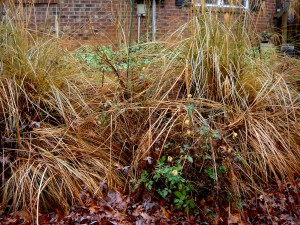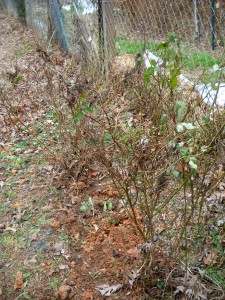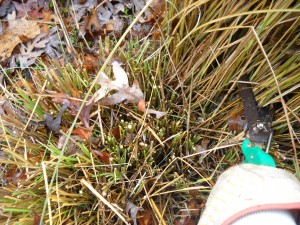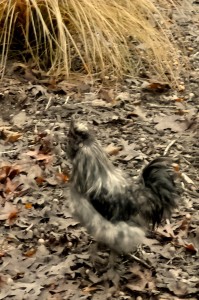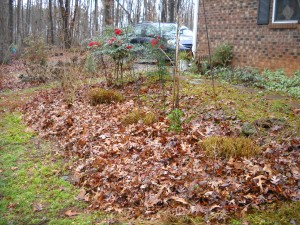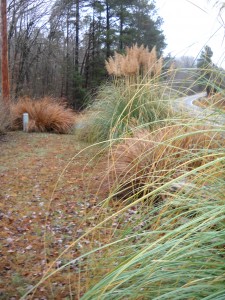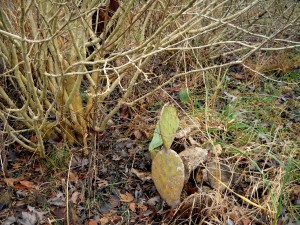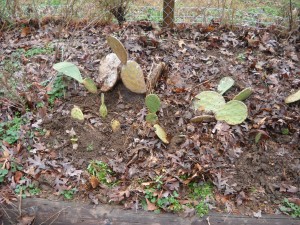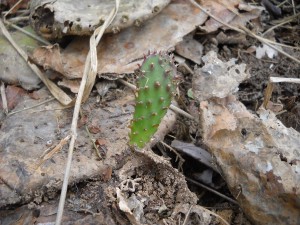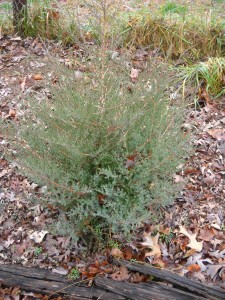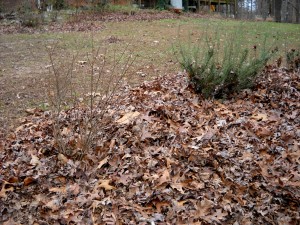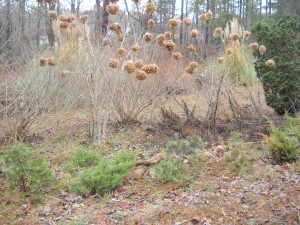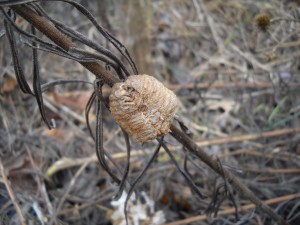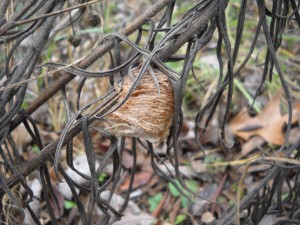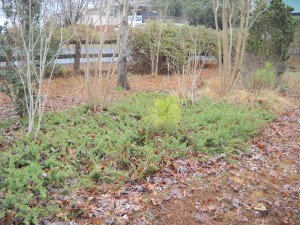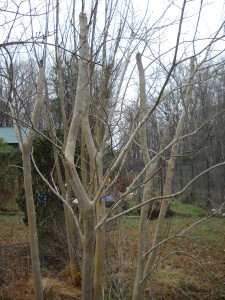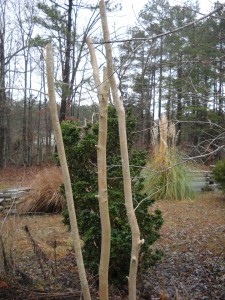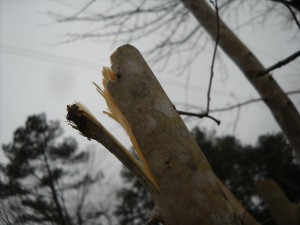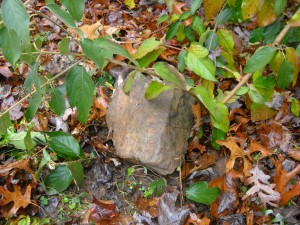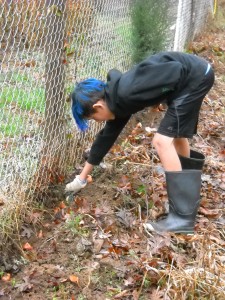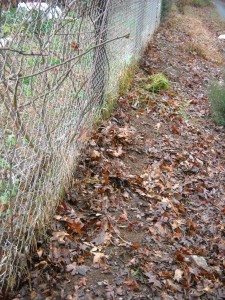Dug In.
Posted on | January 6, 2017 | No Comments
Speaking of the New Year, I had some catching up to do on my To Do list. “Weed the perennial bed” and “Transplant bushes” had been on the list for all of 2016. That’s because I meant to do it in the winter of 2016 but I missed my window of opportunity. I find it best to transplant bushes when they are dormant and there are lots of winter rains to soften the ground. Ditto with pulling the Johnson grass when it is yellow and weak and its massive roots are in loose saturated soil. All of that requires cold winter temperatures and winter rains. We always get the rain but sustained cold temperatures to make the plants dormant are harder to come by. Either it didn’t get rainy and cold for very long last year or when it was rainy and cold I was hunkered down in front of the woodstove. Hard to say. But I’d put my money on the woodstove.
However, 3 days of rain with dropping temperatures meant it was finally time to get it done. That and the fact that the pampas grass in the front yard had almost swallowed the Knock Out roses.
I knew when I planted those immature roses that they were too close to the fledgling clumps of pampas grass. The problem is that I have difficulty following the spacing directions on plants. Since I rarely buy anything bigger than a 1 gallon pot (and sometimes smaller than that) off the discount rack, the tiny plants look ridiculous spaced 4-5 feet apart. Plus, plants off the discount rack are already struggling and spindly—if they aren’t planted close together they tend to just get lost in my wild and wooded environment. Besides, all that spacing requires weeding or mulching between the plants and, people, that ain’t happenin’. Better to plant them close together and let them help each other shade out the weeds trying to creep between them.
The downside is that if the plants do survive they eventually have to be moved and spaced out properly. In this case, the roses really weren’t getting quite enough sun for a good bloom anyway. So I dug them up and moved them down to the garden fence. Ordinarily I don’t plant tall, bushy plants against the garden fence because I don’t want to shade the vegetables. But I’ve found roses against the fence help hide the chain link and also let me grown lettuce, spinach, and other shady crops in the first row of the garden much later into the season (even July), by providing a bit of break from summer sun. They should be happy there.
With the roses gone, I decided to go ahead and prune the pampas grass. I love pampas grass because its appealing even into winter with its feathery plumes. But I hate cutting down its razor sharp leaves in the spring to help it grow. Since it was cool and rainy, the pampas was more dull and wilty than usual so I decided to go ahead and take care of a spring trim. The clumps can be daunting but I just started in with hand clippers, grasping a small bundle of stalks at a time, cutting them, hauling them out, and repeat, repeat, repeat.
My dad has a pair of hedge clippers that are great for this job but that involves a lot of noise and fumes and gasoline. I was just happy slowly but surely trimming away. It’s old fashioned, I know, but I find repetitive, mindless work isn’t always as tedious as it is just simple and calming. Especially listening to the Battle of the Roosters. My dominant Delaware rooster, Michael, does not generally tolerate crowing from the smaller Silky rooster. But the Silky had slipped out of the pasture into the front yard as soon as he saw me with the shovel. Chickens realize quickly that garden tools mean fresh, turned earth which means fresh new bugs, grubs, and worms. The Silky felt quite safe, shadowing me in the front yard and crowing happily. Which forced a challenging crow from Michael inside the barn yard, which got a response from the Silky, which got an angry response from Michael, which got another reply from the Silky, which got another from Michael, etc, etc, etc. Eventually the rooster a few houses down got into the action (which made Michael apoplectic!) and a crowing symphony broke out.
Maybe you hate roosters. Maybe you hate the thought of pulling that pampas grass out a handful at a time. But you’d have to laugh if you heard that Silky joyfully crowing up a storm and then ducking under the pampas grass while Michael stormed around the barnyard, hunting for his challenger. The Silky had a great day…..
and the pampas grass got trimmed.
I headed down the driveway to clip the grasses growing by the road. I have a variety of pampas and miscanthus planted along the property line with the street. Once I got down there, though, I remembered that those grasses were over 10 feet tall and 4 feet wide. So I made a mental note to call my dad about those hedge clippers. ‘Cause old-fashioned is not the same as stupid.
By the road I noticed some more plants that needed new digs. A lilac bush near the back was clearly being overshadowed by the mock orange and my prickly pear was withering away under the tremendous growth of the Rose of Sharon.
I have always loved prickly pear because it reminds me of my years in Texas. I have been trying to get a large stand of the cactus established for years, but it grows slower than the bushes and shrubs off the discount rack so it always gets choked out. I have a long raised garden bed that I have slowly been filling over the years with plants off the discount rack. I got a discount on a bushel of daylilies one year and they have gradually been naturalizing from from the eastern edge of the bed toward the middle. On the other end I add perennials as they show up on sale. I have some salvia and some trailing verbena, some shasta daisies and some ice plants, some yarrow and some guara. I’ve planted more than that, but sometimes discount plants are too dead to salvage. And sometimes you plant discount plants, forget you planted them, and don’t water them for weeks. Those ones die, too.
I keep the section of the bed that is not in use covered with leaf debris to keep down the weeds. It doesn’t work perfectly but it’s better than nothing and it gives me a place to toss the leaves from the yard when I rake in the fall. I went to where the guaras ended, pulled back some of the leaves, and dug in the the scruffy survivors of the prickly pear. The nice thing about cactus is that all you need is one bitty live part in order for it to regrow. The pieces that look dead and dried up, or soft and slimy, will still grow green cactus sprouts as soon they get a sprinkle of dirt and a splash of sunshine. So even though this cactus looks rough in its new home, it should do just fine here.
The even better part of prickly pear is that baby cactus sprouts are adorable. Awwww.
While I was in that garden bed I thought about digging up the cedar trees that are growing in it. Like I said, the leaf debris is not a perfect mulch and the cedar trees seeded themselves there years ago. I let them grow because of The Other Half. He loves cedar trees. I personally hate cedar trees. Walk through the woods around here and the snapped off lower branches of a cedar tree are just waiting to poke out your eye. I picked up a kid once that hurt himself climbing a tree and had a puncture wound in his calf all the way down to the bone. I knew even before we arrived in the ambulance, that we’d find that kid sitting at the base of a cedar tree.
Yep. Just as I thought. Cedar trees might smell nice. Or make nice fence posts. But only after you clean off the blood and chunks of flesh.
As luck would have it, my sheep and goats quickly cleared our woods of most of the cedar trees by peeling off the bark so that they died. The Other Half was miffed and so I have let the little cedars grow in my garden bed. Eventually he can transplant them somewhere away from the critters. Which I would have done myself this year, except I do not know where there is any space away from my critters. So they’re still there. Better luck next year, cedars.
I did dig up the crowded lilac bush and moved it to the front yard by the rosemary. There’s not a lot of sunshine in the front yard because there are so many mature oaks. I actually only planted the rosemary at the base of this tree because I had to prune my rosemary in the herb bed and I couldn’t bear to throw baby rosemary starts away. I actually expected the rosemary to die. But it flourished and if that spot gets enough sun for rosemary then it should be fine for the lilac.
This variety of lilac is supposed to get 7-10 feet tall but I’ll keep it trimmed into shape. Or I won’t and it will eat the rosemary the same way the pampas grass tried to eat the rose bushes. Or the rosemary will shade out the lilac bush and suck up the little bits of moisture in the ground that the oak doesn’t get and the lilac will quickly wither and die. Hard to say. Don’t let people tell you gardening is the for the tender-hearted. This is practically a rosemary-lilac cage match.
With the prickly pear and the lilac bush gone I had a big open space for weeds to grow. So I divided up some of my creeping juniper and transplanted the clumps into the space front of the mock orange, the Rose of Sharon, the peegee hydrangea and forsythia. I planted them close together so that they would fill in quickly. Also, because planting things close together is my specialty.
With all that digging done there was nothing left to do except weed. I weeded the leaf debris of everything except the cedar trees, pulled up chickweed from around the perennials, trampled down the dried up stalks of wild ox-eye, and yanked Johnson grass out of the rest of the juniper. The good news was that I found several preying mantis egg cases in the ox-eye. I left those sections intact in the hopes that my preying mantis population would continue to increase. And my squash bugs decrease proportionately.
Which just left that annoying pine tree in the middle of the juniper.
I tried to cut through the stem with the shovel but it refused to yield. So I had to hike up the driveway to get the tree loppers. But the worst part of the tree loppers isn’t the trek up the driveway. The worst part is that once you have the tree loppers and cut down a pine tree, you can’t stop. You want to cut more stuff. You need to cut more stuff. I looked around and settled on the crepe myrtle. I figured cutting it back would give it more blooms. And I chose the height to cut to based upon the limbs I could reach without having to go get the stepladder. Then I cut away.
The first tree wasn’t so bad.
But I might have gotten carried away with the second one.
Good thing I made nice, clean careful cuts. Kinda. Sort of. Eh.
On the way up the driveway I trimmed the peegee hydrangea, the beautyberry, and the weigela that are stuck between the leland cypress. Those bushes are close to getting squeezed out by the leland cypress but are way too big to transplant. So I just used a little transplanting hack. I left some of the longer branches in the front of the bush. The I roughed up a patch of soil, pulled the long branch down, and pinned it to the soil with a rock.
Seems simple, but it really works. The branch will root itself and if the back of the bush eventually gets choked out, the front will be an entire new bush, further away from the shade of the leland cypress. Of course, that’s only if you remember why you put the rock there and don’t throw it in the woods and then mow over the fledgling bush while you’re mowing the lawn. ‘Cause sometimes that happens. Also, sometimes you just mow over the rock and it tries to take out your eye or tears up the mower blade. Like the plant’s way of fighting back. Told you gardening was not for the tender-hearted.
I thought I was finished, but then I remembered that the cold and rain was perfect for the tulip bulbs I had stashed in the drawer of the farm fridge. I got the bulbs off the sale rack a couple weeks ago so it was a random assortment of color and styles. But random is good. And getting Little to help plant all 125 bulbs was even better.
I dug the trench and he put in the bulbs. The he harvested some lettuce and broccoli while I covered up the bulbs. Cold and rain makes some beautiful, bright green lettuce and broccoli.
The row of planted bulbs wasn’t as pretty. Just a leafy strip of mud, hiding all it’s bright colors for spring.
But all that transplanting and weeding and pruning will be worth it. Getting everything dug in now should pay off with healthy plants in the spring. And with the cold getting even colder (a forecast of sleet and snow just a few days away!), I had all my outside work done. Which still left lots of time for hunkering down in front of the woodstove. With the last of the chocolate from my stocking and the bottle of Jack Daniels Tennesee Honey that I got for Christmas from a friend. Oh,…wait a minute!….maybe that’s what happened last year. 😉
Comments

Leave a Reply
